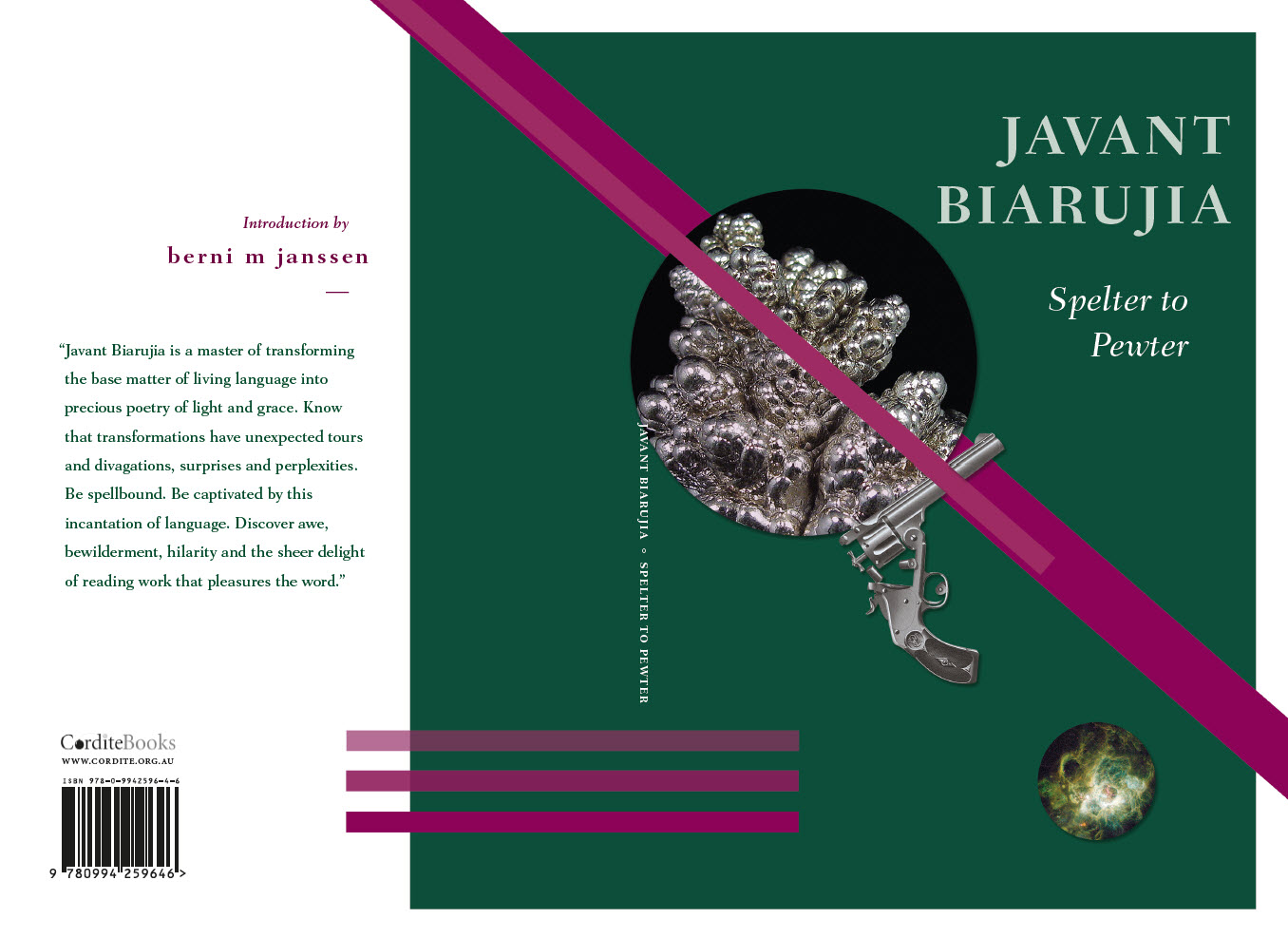
Cover design by Zoë Sadokierski
In Javant Biarujia’s poetry, language matters – matters as in important, and matter as a unifying substance, a material to be transformed, and in so doing, becomes transforming. Particles of language are pounded out, splintered, spliced and mixed. Language is the matter from which his poems are sculpted into refined and polished objects. Matter is energy and these poems vibrate. Emit light, shimmering multiverses.
In Spelter to Pewter, the lineage of Biarujia’s poems is clearly acknowledged; from Zukofsky and the Objectivists, experimentation, shape, syntactic fragmentation and ‘the poem as object’. From Pound via Zukofsky, ‘a poem containing history’, and history not as ‘official’ but history as the all-encompassing lived experience of poets. Biarujia offers us remarkable and capacious poems ‘thinking with the things as they exist’, on matters personal, literary, spiritual, mythological, artistic, political and more. Always playful. Inventive. Incisive. In Spelter to Pewter we see the continuance of a tradition, a liberation of language, that still challenges.
Spelter to Pewter is both the title of the book and its first poem. Split this title, and in the particles exist clues. ‘Spelter’ was once synonymous with zinc and now refers to zinc alloy. The word ‘pewter’ is thought to be derived from the word ‘spelter’. Thus, spelter to pewter, the transformation of language. Pewter, a tin alloy. Both alloys are used to make objects decorative, detailed, hybrid and intriguing.
Split spelter to spell. Spelt.
‘Spell’, a splinter, or chip; language fragmented, where interruption, absence, disjunction and slippage endlessly generate.
To spell out, read letter by letter. Sound out. Each sound of a word is weighed. Each word, an arrangement. Textual elements – possessing the same particles and occupying the same place – are typographically disrupted, recombined and multiplied, and are weighted differently. Biarujia’s are isotopic poems.
Study closely, make out slowly, decipher. Sets of particles, casting a spell, create constellations of vital particulars.
‘Spelter to Pewter’, the poem, is the companion piece to Resinations. Both have 512 lines (8 x 8 x 8, a numerological affair). Where each ‘resination’ was a resin, each stanza in Spelter to Pewter has an element of the Periodic Table spelled out down its spine à la mesostics, a form that John Cage invented. We are spelling out, up and down. ‘Only the imagination of the reader limits the number of the poem’s possible meanings’, said Cage.
‘Brancusi Études’ is distilled and elegant. They have presence on the page as sculptural elements. Brancusi said that an artist should know how to dig out the being that is within matter. Biarujia has done just that.
‘Obje(c)t Fou(nd)’ is composed from others’ texts. This crazy mix-up, as revolutionary as Surrealism in its time, is framed by footnotes, typography and dualist titles – both placing and thickening, and adding weight to the matters political, intellectual, artistic.
Javant Biarujia is a master of transforming the base matter of living language into precious poetry of light and grace. Know that transformations have unexpected tours and divagations, surprises and perplexities. Be spellbound. Be captivated by this incantation of language. Discover awe, bewilderment, hilarity and the sheer delight of reading work that pleasures the word.
As Zukofsky said, ‘Felt deeply, poems like all things have the possibilities of elements whose isotopes are yet to be found. Light has travelled and so looked forward.’









